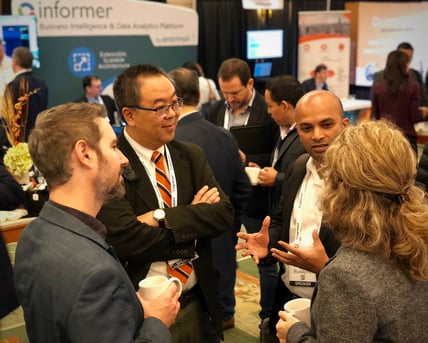At Corinium our team members live and breathe their events. They are constantly engaged in the latest news, content and have their finger on the pulse of change at all times. Each department specializes in their area, so we caught up with Christie, who is Director of Sponsorship for our US conferences about how she helps her clients navigate the complex D&A landscape!
 |
I talk to a lot of vendors in this space. The questions are always the same; What is a Chief Data Officer (CDO)? What is a Chief Analytics Officer (CAO)? Or a Chief Data Analytics Officer? What is the difference between a CDO and a CAO and a CDAO? Why is this important? Who do I need to talk to? How do they work with the CIO or the CMO? Who do I actually want or need to talk to?! The reality is, there is no clear answer because each company is different, has different business models, organizational design, and job title may not be reflective of job role in organizations who task their executives with one thing and then require them to do three to four times more due to lack of resources. In addition to this, it also varies by industry and location! |
After thousands of hours over the years speaking to the market, here’s my assessment
- Chief Data Officer – This is the person responsible for collecting, storing, cleaning, maintaining compliance and privacy of data. They typically work very closely with the CIO.
- Chief Analytics Officer – They take the data and drive actionable insights. They often times oversee the Data Science teams and come up with ways of looking at data that drive revenue, productivity, supply chain, efficiencies, merchandising, etc. they work closely with the CDO.
- Chief Data Analytics Officer – This is a hybrid of the two and the way many companies are leaning as the confusion between the two becomes more prevalent. They often times will have a data and analytics team underneath them – or various teams. They also work with the CDO, Data Science teams, CMO, CAO, etc.
- Chief Data Scientist – Often times these executives can also be head of their analytics departments. They have a number of tools in their tool chest and use Machine Learning/ AI, programming languages, statistics, NLP, SQL, etc. to address business challenges within their company.
Obviously these roles vary by company and my definitions are incomplete at best, but you get the general idea.
When I started looking at this industry three years ago, we could count the number of CDOs, CAOs, and CDAOs on our hands. There were 9 in Europe, a handful more in the USA. Today, we see a lot more, but we also see them concentrated in industries whose regulatory environments are pushing them towards adoption of these titles and programs.
Financial Services is the most obvious industry as the financial crisis was a catalyst for the adoption of these positions. They also collect tons of transactional data of all different kinds, shapes and forms. Insurance and its regulatory complexities and ever-changing environment has also compelled it to keep up with its adoption. There is also a ton of Data in these industries from transactional data to underwriting, trading, compliance…the list goes on.
In the last few years though data has become currency and other companies who are compiling tons of it are getting the game. Big box retailers like Target and Walmart have big data/ analytics/ data science teams who are giving them an advantage over the smaller companies that haven’t quite embraced this technical revolution. Companies like Amazon and newer e-commerce companies have structured their companies around data and have naturally found themselves with more tools than those more traditional retailers. As a result, this industry largely is behind others in terms of looking at data across the organization. We find silos where the “Head” of the data/ analytics teams sit with supply chain, marketing, merchandising so the CSO, CMO, etc. are the point people for these functions, but as they are not looking at data across the organization, they may be missing out on valuable correlations. Additionally, historic data, current data and future data sets all have value but need to be treated and used differently. If done well, these programs can generate revenue, increase efficiency across the organization and contribute to the success (and sometimes survival) of a company. If done poorly, it can do just the opposite.
If you think it’s confusing when looking at industries, try looking at the coastal and geographic differences in how companies are handling data and analytics. I would argue that on the East Coast, companies tend to be older – and especially financial institutions which have been around for a long long time and typically, their systems are older. So what does a company do? Well, they hire people who then evaluate tools that make these legacy systems work.
On the West Coast, they have Silicon Valley, so they tend to invest in technology before people to fix their systems and do the work they need to do. We also find that as industries are different coast to coast, and city to city, so are titles. So if you have a high concentration of Financial services and Insurance companies in one city, you’ll find a lot of C-level titles in this space. If you have a high percentage of retail companies, not so much unless you have a Fortune 500 company nearby.
 |
As a vendor in this space, what do you do? How do you focus? Who do you talk to? |
| As an executive in this space, what role do you fit into and how can you show value as an employee? |  |
Well, you look at your strategy overall and you don’t implement a blanket marketing and sales strategy. Instead, you hyperlocalize it.
The large events are great to get some brand recognition and media press around your solution and you will meet volume, but in reality, you need to sell differently depending on where you are just as you would if you were going internationally and selling in China versus France. The East Coast is easy cause there is a high concentration of these more mature and evolved companies as well as events covering these. The Central US is segmented into different industries and cities so concentration of CDO, CAO and CDAO titles isn’t as much so you have to look at Director and VP titles more than you would on the East. The West is similar with San Francisco leading the charge due to its proximity to Silicon Valley.
I caution clients against going too senior in some places as it can’t be done no matter what the company tells you. You have to design your sales strategy around the different cities and demographics and design those groups. So for smaller cities in the USA, focus on roundtables, 30-50 people events with those senior level influences and titles. If you are in a large city like NYC, go for a larger event that focuses on executives.
Back this up with a digital strategy that engages your audience in between events. Generate leads, feed your sales team and give them the tools they need. Don’t forget that the executives in these roles live, breathe and work in data and analytics and are thirsty for knowledge and tools that can give them the upper hand.
Navigating decision-making units can be overwhelming as these companies are complex, titles are misleading sometimes and in most companies it’s not just one person anymore but a team effort of evaluation that depends on budgets, timing, etc. Accelerating this decision making process can be done with the right understanding of the market and the right strategy.
 |
For more information on this or if you want to talk through this market, call or message me! |



.jpg)
.png)
.png)

